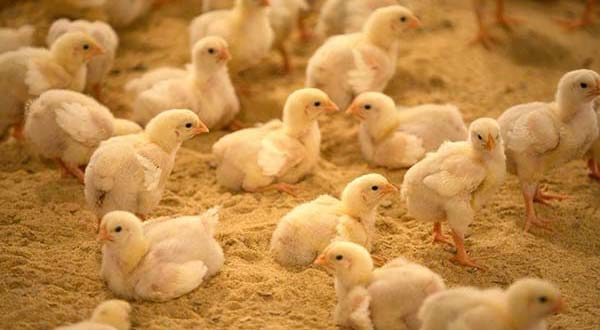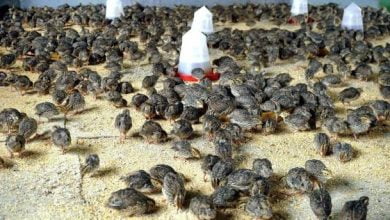Impact of Ochratoxin on Poultry Production

Impact of Ochratoxin on Poultry Production
Ram Singh*, A B Mandal and Avishek BiswasICAR-Central Avian Research Institute, Izatnagar- 243 122, Bareilly (U.P.)
Mycotoxins are low molecular weight secondary metabolites produced by certain strains of filamentous fungi such as Aspergillus, Penicillium and Fusarium, which invade crops in the field or may grow during storage under favaourable conditions of temperature and humidity. The occurrence of mycotoxins in agricultural commodities depends on region, season and the conditions under which particular crop is grown, harvested or stored.
Although several hundred mycotoxins are known, the mycotoxins of most concern based on their occurrence and toxicity are aflatoxins, ochratoxin A, trichothecenes, zearalenone, fumonisin and moniliformin. Among these Mycotoxins, ochratoxin deserves special attention due to several reasons: (a) ochratoxin A (OTA) possesses carcinogenic, teratogenic, embryotoxic, genotoxic, neurotoxic, nephrotoxic and immunosuppressive properties; (b) OTA is present in various feedstuffs worldwide due to the ecological variety of Aspergillus and Penicillium, both are OTA producing fungi and (c) OTA frequently co-occurs with other Mycotoxins such as citrinin, fumonisin, penicillic acid and aflatoxin, all these mycotoxins possess nephrotoxic, carcinogenic and cancer promoting activity.
The term “Ochratoxin” was derived from the name of the mould: Aspergillus ochraceous from which the ochratoxins were first isolated. Ochratoxins are produced by several species of Aspergillus (Aspergillus ochraceous) and Penicillium (Penicillium viridicatum). Aspergillus ochraceous produces OTA in hot climates, while Penicillium viridicatum produces it in temperate climates. There are 7 types of ochratoxins of which ochratoxin A (OTA) is the most toxic. Ochratoxin A is chemically defined as 7- carboxyl-5-chloro-8-hydroxyl 3, 4-dihydro-3-R-methyl isocoumarin linked to L-β-phenylalanine.
The main effect produced by ochratoxin is nephrotoxicity but can also produce a liver disorder which produces an accumulation of glycogen in hepatic and muscular tissue. The signs are dehydration, emaciation, dry gizzard, bleeding in mucosa of proventriculus and catarrhal enteritis in young chicks. A significant reduction in egg production and increase in egg shell elasticity are seen in laying hens when the diets contain 3 ppm or more ochratoxins. Chicks died of ochratoxicosis show white flake like deposits in kidneys, ureters, heart, pericardium, liver and spleen as observed in visceral gout.
Clinical signs of ochratoxin toxicity: Ochratoxin is primarily a nephrotoxic in poultry, that is its major effect is on the kidney of the intoxicated bird, but it does have some secondary hepatotoxicity. The major presumptive diagnosis index of this mycotoxin is pale and enlarged kidney. Ochratoxin can effect the poultry industry in a number of ways: (1) Depresses growth of poultry, (2) Acts as an immune-suppressant making birds more susceptible to diseases, (3) Makes birds more susceptible to bruising and (4) Affects nutrient absorption and metabolism. Several experiments reported negative effects of OTA contaminated feed on poultry performance:
Broiler chicken: Day-old chicks given feed containing 100 ppb ochratoxin A up to six weeks of age had no adverse effect on growth performance, organ weight and certain biochemical parameters in broiler chickens in our experimental station. However, the production parameters (weight gain, feed efficiency), organ weight and biochemical parameters were adversely affected at 150 ppb OTA level in feed. Experimentally induced ochratoxicosis with 200 ppb ohratoxin resulted in reduced production performance, enlargement of liver, regression of bursa, decreased total serum protein, haemoglobin and increased level of uric acid, creatinine, alkaline phosphatase, gamma glutamyl-transferase, sorbitol dehydrogenase, glutamic dehydrogenase, aspartate aminotransferase, alanine aminotransferase, lactate dehydrogenase, acid phosphatase and H/L ratio; and immune-suppression.
Histological examination of the kidney sections of broiler chicks fed contaminated feed with 200 ppb OTA showed significant degeneration of the architecture and cellular organization of the renal parenchyma, cloudy swelling and numerous abnormal tubules (atropic changes in the tubule) having degenerated and necrosed epithelium, dilated lumen and multifocal aggregates of mononuclear cells. The liver samples of the OTA (200 ppb) fed birds showed diffuse degenerative changes of hepatocytes with vacuolated cytoplasm, dilated and congested sinusoids, hyperplastic bile ducts, multifocal aggregates of mononuclear cells around bile duct and portal area.
Postmortem lesions reported in growing chicks after consumption of OTA contaminated feed were dehydration, emaciation, a dry and firm gizzard with erosion on the koilin layer, proventricular mucosal haemorrhages and catarrhal enteritis; swollen, enlarged and pale kidney; enlarged, friable, haemorrhagic and pale liver; decreased weight of lymphoid organs; ureates deposits on the kidney, heart, pericardium, liver and spleen (visceral gout) are characteristics of ochratoxicosis. In another study, increased level of serum uric acid, urea and creatinine and decreased levels of serum protein were recorded with a high level level of urinary protein excretion, indicating a possible severe damage to kidney functions. These metabolic disorders might be responsible for the increased weight of liver and kidney organs involved in the detoxification and elimination of ochratoxin from blood. In addition, lymphoid organs (bursa of Fabricius, thymus and spleen) showed degenerations and reduced weight caused by the reduced number of antibody producing cells. Body weight of chicks fed diets containing 0.4 and 0.8 mg/kg of OTA, from day one to five weeks of age, was one-third and one-half of that of the control group (OTA not added), respectively. Feed intake of chicks fed contaminated diets was lower than that of the control. Moreover, feed conversion rates of the groups fed contaminated diets at 0.4 and 0.8 mg/kg were, respectively, about 10 and 20% higher than the control.
The mortality percentages during the experiment indicated a direct OTA dose dependent relationship. OTA intake significantly decreased thyroxine and hemoglobin concentrations, packed cell volume percentages, red and white blood cell counts, thymus weight, and humoral and cell-mediated immune responses in a dose and time dependent manner. One-day-old chicks given feed containing 0.2 to 1.6 ppm of OTA during a period of 2 to 3 weeks had delayed development and reduction of live weight. Chickens fed a diet containing 2 ppm OTA in feed for three and four weeks, exhibited alterations in internal organs such as pale swollen kidneys and yellowish, friable at palpation and enlarged livers. Histopathological examinations showed vacuolation and megalocytisis of hepatocytes, hyperplasia of the biliary epithelium and hypertrophy of renal proximal tubular epithelial cells. Chicks fed on contaminated feed with 5 ppm OTA for six and ten weeks showed histopathological, hematological and biochemical changes. The blood level of chicks showed an alteration of hematopoiesis characterized by a slight anaemia. Increased serum levels of uric acid, urea and creatinine, and reduced levels of serum total protein were observed, together with a high urinary protein excretion, indicating a possible severe damage to kidney functions.
These metabolic disorders may be responsible for the high weight observed for the liver and kidneys as these are involved in detoxification and elimination of OTA from blood. Lymphoid organs; thymus, bursa of Fabricius and spleen showed degenerations and decreased weight caused by the reduced number of antibody producing cells. Weight loss, diarrhea, excessive urine excretion and renal lesions have been noted in chickens fed a diet contaminated with 2 ppm OTA. Dietary ochratoxin in broiler chickens caused significant alteration in hematological parameters as reduction in Hb concentrations, PCV and RBCs, WBCs, lymphocyte and heterophil counts. With regard to immunity, effects of ochratoxin on the immune system of poultry include inhibition of humoral, cellular and innate immune response, cellular depletion of lymphoid organs, depressed delayed hypersensitivity responses, depressed blood monocyte phagocytic activity, leucopenia and impaired phagocytosistosis by heterophils. Major effects of ochratoxins are the inhibition of protein synthesis (translation) through blocking phenylalanine tRNA synthetase. Dietary OTA at 150 ppb level significantly (P<0.05) reduced the HA titre against sheep RBCs.
OTA interferes with protein, DNA and RNA synthesis through competitive inhibition of phenylalanine-t-RNA synthetase by phenylalanine moiety of OTA that leads to decrease plasma proteins and immunoglobulin. Also, leucocytopenia (lymphocytopenia and monocytopenia) that is noticed during ochratoxicosis can adversely affect immunoglobulin production. OTA inclusion at 200 ppb level in the diet of broiler chickens caused significant (P<0.05) reduction in CMI response to PHA-P. Suppression of CMI response in chicken due to ochratoxicosis might be due to reduction of T-lymphocyte count and phagocytic ability of spleenic macrophages after feeding OTA contaminated feed. Phagocytic activity of chicken heterophils is impaired in OTA intoxicated birds. Serum immunoglobin concentrations are reduced in toxicated hens. Lymphoid organ atrophy is attributable to fewer immunoglobulin-containing cells.
Layers: Ochratoxicosis in laying hens is characterized by body weight loss, impaired feed efficiency, severe nephropathy, a delay in sexual maturity, reduced egg production, depressed hatchability of fertile eggs, and poor progeny performance in chicks from eggs laid by hens consuming ochratoxin contaminated feed. Ochratoxin in feed of laying hens influenced embryo mortality and embryonic anomalies with most changes reflected in liver and kidney disorders. One-day-old White Leghorn chicks exposed to diet with 0.3 to 1.0 ppm of OTA or 26 week old White Leghorn laying hens given feed containing 0.5 to 4.0 ppm of OTA, for a period of 341 and 42 days, respectively had serious renal lesions, microscopic changes and histological alterations in the liver in chicks and a decrease in egg production, egg weight, feed intake and body weight in laying hens.
White Leghorn laying hens fed diet with 0.5 to 1.0 ppm of OTA had a significant decrease in egg production, strainedegg shells and increased levels of uric acid in their serum. The effect of different levels of OTA contamination in feed (1, 2 and 4 mg/kg) on protein and energy utilization in white Leghorn hens was studied. Protein retention was negatively affected by OTA, suggesting a reduced nutrient absorption caused by the toxin. Energy partitioning showed a progressive decrease in egg deposition energy as OTA concentration increased.
These alterations on protein and energy metabolism, together with the toxic effects previously described in poultry, may be responsible for the reduction of performance registered both in terms of number and weight of eggs produced by laying hens fed OTA. The reduction in the performance of laying hens was influenced by the level of contamination and length of exposure to a diet contaminated with OTA. Temperature also had an effect: egg production was lower in laying hens reared at 33 °C than at 25 °C. Laying hens fed on a diet contaminated with 2 ppm OTA significantly reduced daily feed consumption, egg mass production, serum triglyceride concentrations and increased relative liver weight as compared to control birds.
Ducks: In duckling, ochratoxin has been reported to cause retarded growth, enlargement of the kidney and liver and regression of the thymus. Khaki Campbell ducks, given a diet containing 2.0 ppm of OTA from birth until 18 days of age, suffered from delayed growth, enlarged livers and kidneys and regression of the thymus. Microscopic observations showed an accumulation of glycogen in the liver and an infiltration of lymphoid cells in the kidneys. The histopathological alterations in kidneys during ochratoxicosis include tubular casts, tubular dilation and hyperplasia of tubular epithelium. The liver showed vacuolar change in hepatocytes associated with reversible increase in glycogen content. Hepatocyte vacuolation is due to lipid accumulation.
Turkeys: The main toxic effects of ochratoxicosis in turkeys were high mortality, nephrotoxicity and decreased feed intake. Turkey’s poults fed with diets containing 1.0 to 8.0 ppm of OTA from birth until 3 weeks of age suffered from delayed development, reduction in water intake, decreased feed utilization efficiency, enlargement of the proventriculus and gizzard; a regression of the thymus, an increase of uric acid in plasma, serious osteoporosis and death. Cell mediated immune response as measured by delayed hypersensitivity reactions to avian tuberculin and to bovine serum albumin in birds were significantly depressed in growing turkeys fed OTA contaminated feed.
Quails: Eggs of Japanese quail females fed a diet with 16 mg/kg of OTA had significantly higher percentages of early embryonic deaths. Fertility and hatchability of eggs were greatly reduced by the inclusion of 16 mg/kg of OTA.
Ochratoxin interactions with other mycotoxins: Concentrations of individual mycotoxins under natural condition associated with poor production performance are usually lower than those reported to cause toxic effects in controlled research studies. This could be due to the fact that the presence of different mycotoxins in a single feed may lead to synergistic interactions among multiple mycotoxins. When ochratoxin is present with aflatoxin as a co-contaminant of feed, they interact in a synergistic manner. This indicates that the toxicity that results from dual exposure to ochratoxin and aflatoxin is much greater than the sum of the individual toxicity of these mycotoxins.
This could be one reason why very low levels of aflatoxin in the field produce significant effects in poultry compared to laboratory studies where only a single mycotoxin is studied. When ochratoxin (a nephrotoxin) and aflatoxin (a hepatotoxic) were present as co-contaminants of feed, there was greater nephrotoxicity, higher OTA concentration in liver, greater relative kidney and gizzard weights and less weight gain as compared to either mycotoxin fed individually. The co-contamination of OTA and cyclopiazonic acid significantly reduced the levels of serum protein, albumin and cholesterol, whereas uric acid, triglycerides and creatine kinase activity were increased. Citrinin and penicillic acid were found to potentiate the nephrotoxic and carcinogenic effects of OTA, respectively.
Ochratoxin causes significant losses to the poultry industry as it has negative effects on performance and health of birds. Ochratoxin can produce a significant reduction in the performance of poultry even at low concentration (150 ppb). The signs of ochratoxicosis in poultry include reduced feed intake, growth rate and egg production, feed conversion efficiency and increased mortality due to acute renal failure.
Moreover, ochratoxicosis leads to poor egg shell quality, higher incidence of eggs with blood spots, reduced embryo viability, decreased hatchability, and poly-urea with large volumes of wet faeces. The post mortem lesions are pale and grossly enlarged kidney, fatty liver, urate deposition in joints and abdominal cavity (at high exposure levels), depletion of lymphocytes and with it strong suppression of cellular immunity thus enhanced susceptibility to viral infection. Ochratoxin also induces degenerative changes and an increase in the weight of the kidney and liver as well as a decrease in the weights of lymphoid organs.



